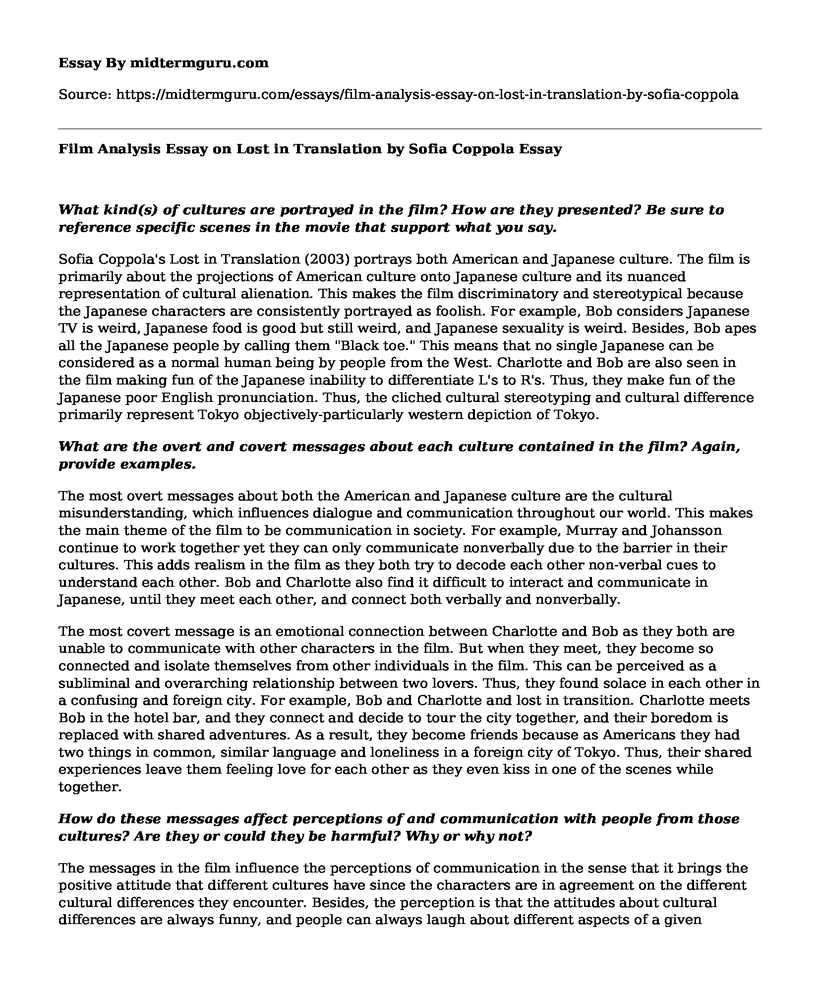What kind(s) of cultures are portrayed in the film? How are they presented? Be sure to reference specific scenes in the movie that support what you say.
Sofia Coppola's Lost in Translation (2003) portrays both American and Japanese culture. The film is primarily about the projections of American culture onto Japanese culture and its nuanced representation of cultural alienation. This makes the film discriminatory and stereotypical because the Japanese characters are consistently portrayed as foolish. For example, Bob considers Japanese TV is weird, Japanese food is good but still weird, and Japanese sexuality is weird. Besides, Bob apes all the Japanese people by calling them "Black toe." This means that no single Japanese can be considered as a normal human being by people from the West. Charlotte and Bob are also seen in the film making fun of the Japanese inability to differentiate L's to R's. Thus, they make fun of the Japanese poor English pronunciation. Thus, the cliched cultural stereotyping and cultural difference primarily represent Tokyo objectively-particularly western depiction of Tokyo.
What are the overt and covert messages about each culture contained in the film? Again, provide examples.
The most overt messages about both the American and Japanese culture are the cultural misunderstanding, which influences dialogue and communication throughout our world. This makes the main theme of the film to be communication in society. For example, Murray and Johansson continue to work together yet they can only communicate nonverbally due to the barrier in their cultures. This adds realism in the film as they both try to decode each other non-verbal cues to understand each other. Bob and Charlotte also find it difficult to interact and communicate in Japanese, until they meet each other, and connect both verbally and nonverbally.
The most covert message is an emotional connection between Charlotte and Bob as they both are unable to communicate with other characters in the film. But when they meet, they become so connected and isolate themselves from other individuals in the film. This can be perceived as a subliminal and overarching relationship between two lovers. Thus, they found solace in each other in a confusing and foreign city. For example, Bob and Charlotte and lost in transition. Charlotte meets Bob in the hotel bar, and they connect and decide to tour the city together, and their boredom is replaced with shared adventures. As a result, they become friends because as Americans they had two things in common, similar language and loneliness in a foreign city of Tokyo. Thus, their shared experiences leave them feeling love for each other as they even kiss in one of the scenes while together.
How do these messages affect perceptions of and communication with people from those cultures? Are they or could they be harmful? Why or why not?
The messages in the film influence the perceptions of communication in the sense that it brings the positive attitude that different cultures have since the characters are in agreement on the different cultural differences they encounter. Besides, the perception is that the attitudes about cultural differences are always funny, and people can always laugh about different aspects of a given customs just as Bob and Charlotte laughed about Japanese customs. Although the ironic attitude may be comical, they can be harmful due to their stereotypical nature that makes the cultural differences more illogical and irrational. Such attempts of satire and comedy can, therefore, have overly ugly and painful cliches.
How might cultural representations in media be altered or improved to become more flexible in how they approach and communicate about culture?
Today, people experience different cultures, and they experience different consequences that form their expectations. As people continue to migrate and tour different cities, authenticity and originality of these regions continue to diminish. This means that as the differences in cultures continue to be diluted; most people will perceive everything to be similar leading to a clinched world. In this case, media representation would not be able to employ the stereotypical barriers in language and culture. People will not feel the discriminatory aspects in media representation and approach about culture.
Cite this page
Film Analysis Essay on Lost in Translation by Sofia Coppola . (2022, Oct 26). Retrieved from https://midtermguru.com/essays/film-analysis-essay-on-lost-in-translation-by-sofia-coppola
If you are the original author of this essay and no longer wish to have it published on the midtermguru.com website, please click below to request its removal:
- Power Season 2 Episode 10 Review
- UX Design Graduate School: Personal Statement
- Gap Between Historical Musical Knowledge to Present Day Knowledge - Essay Sample
- Essay Sample on War Films
- Movie Analysis Essay on Titanic
- Gartner Magic Quadrant: Security Merchants Ranked by Vision & Implementation - Essay Sample
- Unchained Melody: A Timeless Love Song Inspired by a Prison Movie - Research Paper







